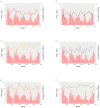Exposure to Chloramine and Chloroform in Tap Water and Adverse Perinatal Outcomes in Shanghai
- PMID: 35682093
- PMCID: PMC9180198
- DOI: 10.3390/ijerph19116508
Exposure to Chloramine and Chloroform in Tap Water and Adverse Perinatal Outcomes in Shanghai
Abstract
Chloramine and chloroform are widespread in tap water due to water disinfection processes. This study was designed to explore the associations between trimester-specific exposure to chloramine and chloroform in tap water and adverse outcomes. This retrospective cohort study included 109,182 mother-infant singleton pairs in Shanghai. A logistic regression model was used to evaluate the associations of chloramine and chloroform concentrations averaged over the whole pregnancy and in each trimester with adverse outcomes, including gestational diabetes mellitus (GDM), gestational hypertensive disorders (GHD), low birthweight (LBW), small for gestational age (SGA), preterm birth (PTB) and prelabor rupture of membranes (PROM). The use of tap water with elevated chloramine levels in the first trimester was associated with GDM (OR = 1.06, 95% CI: 1.03, 1.09), while that in the second trimester was related to GHD (OR = 1.13, 95% CI: 1.09, 1.17). Chloroform levels in the third trimester were associated with LBW (OR = 1.13, 95% CI: 1.09, 1.16), PTB (OR = 1.05, 95% CI: 1.01, 1.08) and PROM (OR = 1.01, 95% CI: 1.00, 1.01). However, tap water chloroform exposure in the second trimester was negatively associated with LBW (OR = 0.95, 95% CI: 0.93, 0.98) and PTB (OR = 0.97, 95% CI: 0.94, 0.99). In conclusion, there are probably no casual associations between current tap water chloroform and chloramine levels and perinatal outcomes. However, more research focusing on the effect of chloramine and chloroform on perinatal outcomes are still warranted.
Keywords: chloramine; chloroform; perinatal outcomes; tap water.
Conflict of interest statement
The authors declare no conflict of interest.
Figures


References
-
- Chaves R.S., Guerreiro C.S., Cardoso V.V., Benoliel M.J., Santos M.M. Hazard and mode of action of disinfection by-products (DBPs) in water for human consumption: Evidences and research priorities. Comp. Biochem. Physiol. C Toxicol. Pharmacol. 2019;223:53–61. doi: 10.1016/j.cbpc.2019.05.015. - DOI - PubMed
-
- Tang Y., Long X., Wu M., Yang S., Gao N., Xu B., Dutta S. Bibliometric review of research trends on disinfection by-products in drinking water during 1975–2018. Sep. Purif. Technol. 2020;241:116741. doi: 10.1016/j.seppur.2020.116741. - DOI
-
- National Research Council Safe Drinking Water Council . Drinking Water and Health: Disinfectants and Disinfectant By-Products: Volume 7. National Academies Press (US); Washington, DC, USA: 1987. - PubMed
Publication types
MeSH terms
Substances
LinkOut - more resources
Full Text Sources
Medical
Miscellaneous

